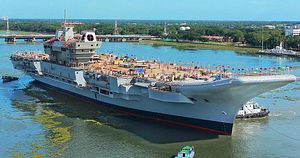India’s first domestically built aircraft carrier, the future INS Vikrant, designated IAC-1, will be ready for induction into service by October 2020, a senior Indian Navy official said this month during a media briefing in New Delhi.
“IAC-I is expected to join the Navy in October 2020. All trial schedules have been worked out. We are going to sign advanced contracts with Cochin Shipyard Limited very soon,” Commodore J. Chowdhary, the Indian Navy’s principal director of naval design, said in January 19.
A 2016 report published by the Comptroller and Auditor-General (CAG) — the Indian government’s principal oversight body—said that the ship would only be ready for induction in 2023. “That was CAG’s version, as far as Navy is concerned, we are confident,” of meeting the earlier deadline, Chowdhary emphasized.
The Vikrant, the lead ship of the Indian Navy’s Vikrant-class, the first aircraft carriers to be designed and built in India under the so-called Indigenous Aircraft Carrier (IAC) program, was officially launched in August 2013 and relaunched in June 2015.
Construction of the carrier was delayed multiple times over the last few years primarily due to hold-ups in procurement including contractual disputes with Russia’s Rosoboronexport over the construction of the carrier’s aviation complex.
The program has also been plagued by cost overruns with the carrier, as of now, costing as much as $4 billion more than originally budgeted. Indian Prime Minister Narendra Modi allocated an extra $3 billion to the IAC program in 2014 to speed up construction of the Vikrant.
The Vikrant was expected to begin sea trials last year with a commissioning originally date set for 2018. (Initially, the carrier was expected to be delivered to the Indian Navy in 2014 and commissioned in 2016 or 2017.) The ship is now slated to be handed over to the Navy by the end of this year for harbor and sea trials.
The 40,000-ton carrier will be fitted with a ski-jump assisted Short Take-Off But Arrested Recovery (STOBAR) launch systems for launching aircraft. “[The] STOBAR system imposes limits on the operational range and armament of aircraft operating from the carrier given that ski-jump takeoff and arrested carrier landings necessitate a high thrust-to-weight ratio for successful take-offs and can only be conducted with lightweight aircraft,” I explained elsewhere.
The carrier, at a length of 262 meters and a width of 60 meters, can operate up to 40 aircraft including Russian-made MiG-29K Fulcrum fighter jets the current mainstay of Indian naval aviation, Kamov Ka-31, HAL Dhruv, or Westland Sea King helicopters.
As I explained in December 2016 (See: “Indian Navy Rules out Tejas Fighter Jet on New Aircraft Carrier”), the Indian Navy has decided against deploying a naval version of HAL’s Light Combat Aircraft Tejas on the new carrier.
The Vikrant, fitted with a close-in weapon system (CIWS) for self-defense, will also feature India’s first domestically assembled long-range surface-to-air missile system (LRSAM).































